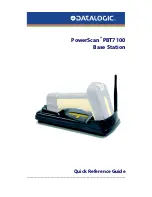
4
Mounting and installation
Connecting sensors to the terminal
18
30302710-02-EN
V7.20141016
Data bits
8
Parity
no
Stop bits
1
Flow control
none
CAUTION
Damage to the equipment caused by short circuit
Pin 4 of port C is live. The voltage depends on the operating voltage of the terminal and is used to
supply the DGPS Receiver from Müller Elektronik.
Other GPS Receivers may suffer damage if connected to this port.
Before connecting a different GPS Receiver:
◦ Check what voltage the terminal is connected to (12 V or 24 V).
◦ Check the pin assignment of the GPS Receiver.
◦ Check the allowable voltage for the GPS Receiver.
◦ Compare the terminal voltage to the allowable voltage for the GPS Receiver.
◦ Compare the pin assignment.
◦ Only connect the GPS Receiver to the terminal, if the voltage range and pin assignment of both
devices don't differ from each other.
During initial start-up it can take approx. 30 minutes until the GPS Receiver has reception. At
subsequent start-ups it will only take approx. 1-2 minutes.
The GPS receiver is mounted on the roof of the tractor.
You have activated a suitable driver. [
1.
- Switch off the terminal.
2. Guide the connection cable from the GPS receiver into the cab.
3. CAUTION! Ensure that the cable is not laid across sharp edges or at risk of becoming
bent. Lay the cable in a place where nobody can trip over it.
4. Connect the connecting cable of the GPS receiver to port C on the terminal.
Connecting sensors to the terminal
The terminal provides you with the possibility of connecting a sensor or the tractor's 7-pole signal
socket to port B. This allows you for example to use the working position signal in the TRACK-Leader
parallel guide.
Most sensors which can be purchased from Müller Elektronik are fitted with a round 3-pole plug. In
order to connect this to the terminal, you will need an adapter cable. A different adapter cable is
needed for each hardware version of the terminal.
Procedure
4.9
















































